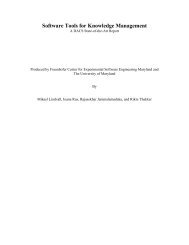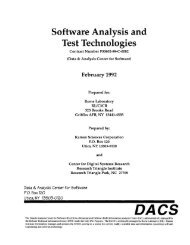Modern Empirical Cost and Schedule Estimation Tools
Modern Empirical Cost and Schedule Estimation Tools
Modern Empirical Cost and Schedule Estimation Tools
Create successful ePaper yourself
Turn your PDF publications into a flip-book with our unique Google optimized e-Paper software.
1. Executive Summary<br />
Project managers <strong>and</strong> project planners are often expected to provide to their management estimates of<br />
schedule length <strong>and</strong> costs for upcoming projects or products. Anyone that has tried to construct <strong>and</strong> justify<br />
such an estimate for a software development project of any size knows that it can be an art to achieve<br />
reasonable levels of accuracy <strong>and</strong> consistency. <strong>Empirical</strong>ly-based cost estimation models supporting<br />
management needs began to appear in the literature during the 1970s <strong>and</strong> 1980s. Support services for<br />
some of these models also became commercially available.<br />
<strong>Cost</strong> models were derived from the collection <strong>and</strong> analysis of large collections of project data. Modelers<br />
would fit a curve to the data <strong>and</strong> analyze those parameters that affected the curve. Early models applied to<br />
custom-developed software systems. New software development philosophies <strong>and</strong> technologies have<br />
emerged in the 1980s <strong>and</strong> 1990s to reduce development costs <strong>and</strong> improve quality of software products.<br />
These new approaches frequently involve the use of Commercial-Off-The-Shelf (COTS) software,<br />
software reuse, application generators, <strong>and</strong> fourth generation languages. The purpose of this paper is to<br />
identify, discuss, compare <strong>and</strong> contrast software cost estimating models <strong>and</strong> tools that address these<br />
modern philosophies.<br />
In evaluating <strong>and</strong> selecting an estimation tool, or estimation tool provider, one should evaluate:<br />
• The openness of the underlying model in the tool<br />
• The platform requirements of the tool<br />
• The data required as input to the tool<br />
• The output of the tool<br />
• The accuracy of the estimates provided by the model<br />
The openness of the tool developer in providing details of the underlying model <strong>and</strong> parameters is one<br />
attribute distinguishing some models from others. Volumes of information have been published about the<br />
models underlying some tools. The vendors of other tools keep information about their model as<br />
proprietary <strong>and</strong> require the user to purchase consulting services to exercise the model. This may not be a<br />
practical problem since beginners will most likely hire consulting services anyways, especially if they are<br />
not a statistician or modeler. But, since many of the models can be implemented with a simple<br />
spreadsheet, being able to underst<strong>and</strong> the “guts” of the model may be important so as to allow one to<br />
enhance the model to meet specific needs.<br />
Several cost models have been implemented in commercial toolsets. Those considering purchasing these<br />
products need to consider the platform on which the product is implemented. Most commercial cost<br />
modeling tools are only available on Windows-based platforms. You will have to determine if your<br />
hardware meets minimal requirements for the toolset.<br />
Major factors in selecting a model include assessing the number <strong>and</strong> complexity of required input<br />
parameters, whether default values can be easily <strong>and</strong> underst<strong>and</strong>ably assigned to these parameters, <strong>and</strong><br />
whether sufficient historical <strong>and</strong> project data exists within one’s organization <strong>and</strong> project to feed the<br />
model. Many of the models are very flexible in modeling specific situations. To achieve this flexibility,<br />
model providers provide numerous parameters to h<strong>and</strong>le multiple situations. A substantial amount of time<br />
may be required to initially set-up a model - one must either answer a number of questions or collect<br />
significant amounts of historical data on similar projects. If an established measurement program exists<br />
within an organization, assembling the required data may not be too difficult. Most models provide ways<br />
<strong>Modern</strong> <strong>Empirical</strong> <strong>Cost</strong> <strong>and</strong> <strong>Schedule</strong> <strong>Estimation</strong> <strong>Tools</strong><br />
2




